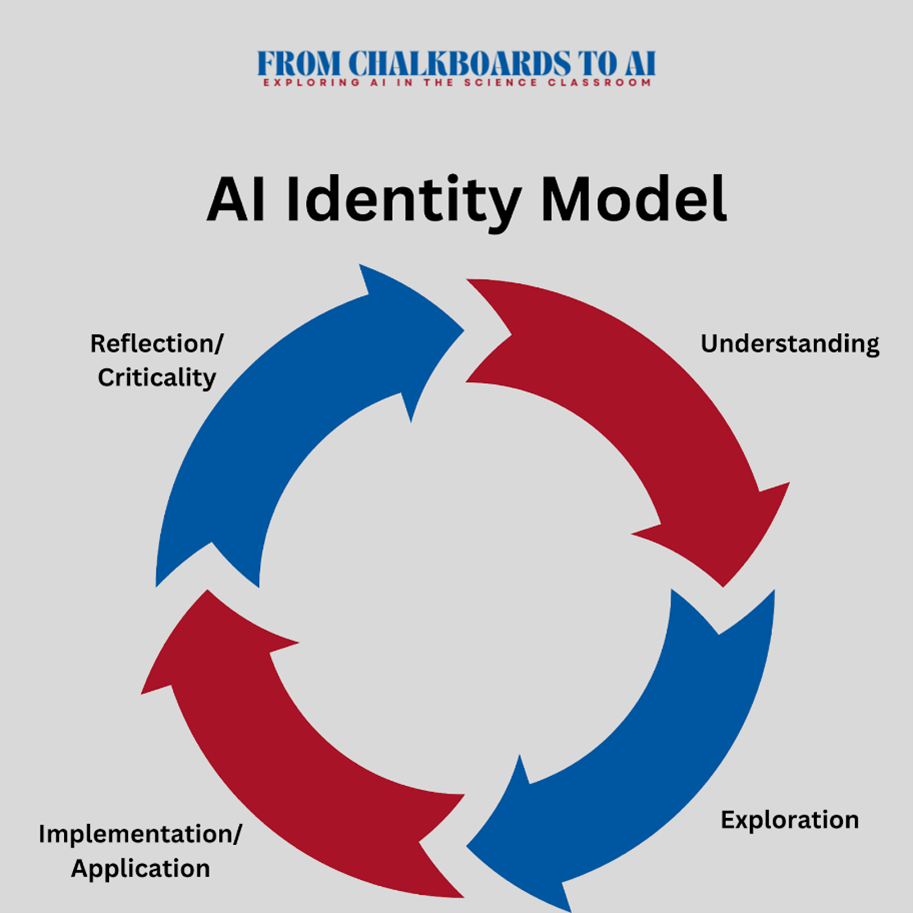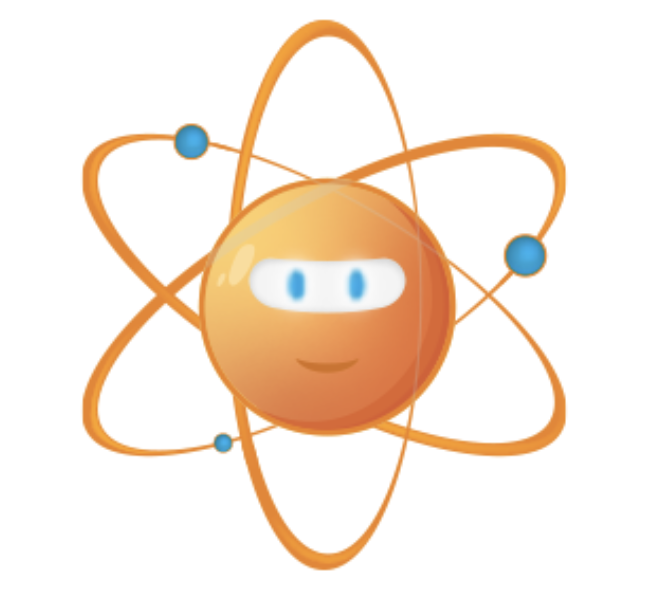From Chalkboards to AI
Finding Your AI Identity as a Science Teacher
By Valerie Bennett, Ph.D. and Ed.D., and Christine Anne Royce, Ed.D.
Posted on 2025-02-10

Disclaimer: The views expressed in this blog post are those of the author(s) and do not necessarily reflect the official position of the National Science Teaching Association (NSTA).
The Concept of STEM Identity as a Model for AI Identity for Science Teachers
When I first considered using AI in my classes, I initially felt a certain level of angst, which evolved into tremendous curiosity as I weighed the benefits and challenges. Along with these considerations, I wondered what my students thought about AI and its impact on their learning. All these reflections and ongoing discussions with colleagues brought me to this month’s blog post on the concept of “AI Identity.” How are my perceptions and beliefs about AI impacting my students’ perceptions and beliefs about AI?
As science teachers, we are aware that how we or our persona (content expert, lab expert, tech guru, and more) shows up in the classroom as a reflection of how we see ourselves and has a tremendous impact on how students “receive or perceive” the science and knowledge expressed during the times we interact with them. The way we discuss a topic and the resources we use are also influential, as evidenced in the Draw a Scientist study (Miller et al. 2018), which emerges occasionally. This notion of “how we see ourselves” is closely related to our STEM Identity: STEM identity refers to an individual's perception of themselves as someone who can succeed in science, technology, engineering, and mathematics (STEM) fields. It encompasses the belief in one's competence and performance in STEM disciplines, as well as the recognition of these abilities by oneself and others. Norman-McKay (2023) states that “STEM identity is a form of social identity and is usually studied and discussed as having 2 key facets:
- Typicality. Believing that who you are as a person is compatible with being a STEM professional.
- Centrality. Feeling that the members of the STEM disciplines accept you.
STEM identity is generally defined as perceiving oneself as a person who can succeed in a STEM discipline/career.” This definition is provided here because as science teachers, we bring our STEM identity when teaching our students. In the same sense, we also bring our “AI Identity” with us to the classroom.
Creating and Defining an AI Identity
We define AI Identity as “one’s level of understanding, exploration (i.e., interaction), implementation, and reflection and criticality of AI tools.” This definition is an extension of the work of Norman-McKay (2023). As we consider our AI identity, we begin with the need to understand how we develop it. A strong AI identity begins with AI literacy. This involves understanding fundamental AI concepts like machine learning and deep learning, as well as familiarizing ourselves with relevant tools such as educational AI platforms, AI-powered lab equipment, and data analysis tools. Asking questions of yourself such as the ones below will help you develop your foundational knowledge.
- How and when do I want or need to use AI?
- Do I understand the basic concept of how AI works?
From understanding, we move toward exploration. Within exploration, we need to determine what the purpose of AI usage is and what tools be used. These tools can be classified into categories such as the following:
- Lesson Preparation
- Data Analysis and Visualization
- Differentiated Instruction
- Scientific Inquiry and Experimentation
- Personal Productivity
Exploring different AI tools that are designed or marketed for different tasks is necessary. While sharing tools and names of tools is helpful, focusing on the tools and using them in a way that helps you construct your understanding and meaning of what the tool can accomplish is essential.
Once you know what tools you would like to use in the classroom and for what purpose, it is important to embark upon the Implementation/Application phase of developing your identity. If you are looking for more understanding of how AI tools can be used to support instruction in the science classroom, a previous blog post in this series, Empowering Science Education With AI: Enhancing Three-Dimensional Learning, will offer several helpful strategies and ideas.
We will mention the importance of Reflection and Criticality here, but this will actually look different based on the different ways that AI is used. Just as being a teacher involves a reflective process, so does the process of reinventing our AI identity, since tools are constantly changing, and AI is a dynamic area. The AI Identity Model below represents this cycle for considering the different stages.

Embracing Our Identity
As science teachers, our AI Identity plays a huge role in our students’ perceptions and responsible use of AI tools, just as our STEM identity impacts our students’ perception of themselves as persons who can succeed in a STEM discipline or career.
As a science teacher, your AI identity refers to how you interact with and implement AI tools in your science teaching practice. While some may categorize this within technological knowledge and consider it part of Technological, Pedagogical, and Content Knowledge, AI Identity is more than that. As previously noted, your AI Identity includes your comfort level with technology, the specific AI tools you use, and how these tools align with your educational philosophy and science curriculum goals. Defining and acknowledging your AI Identity helps you leverage AI to complement your teaching style and meet your students’ scientific learning needs.
Steps to Identify Your AI Identity as a Science Teacher
- Self-Assessment. Start by evaluating your own understanding of AI, then proceed with how you currently use AI in your science teaching. Do you use AI for lesson planning, grading, or student engagement in scientific concepts? Recognizing your current practices will help you understand your starting point.
- Explore AI Science Tools. Familiarize yourself with various AI tools available for science education.
- Align AI Science Tools with Standards and Instructional Goals. Consider your teaching goals and how AI can help achieve them. Whether it’s improving student understanding of complex scientific concepts or saving time on administrative tasks, choose AI tools that align with these objectives.
- Reflect on Integration Style. Consider how you prefer to integrate AI into your science lessons. Are you an early adopter who likes experimenting with new tools, or do you prefer a more cautious approach? Understanding this will guide your AI journey in science education.
Practical Tips for Embracing Your AI Identity in Science Education
- Start Small. Begin with one or two AI tools that address your immediate needs in science teaching.
- Collaborate. Join communities of science educators who use AI. Sharing experiences and strategies can provide valuable insights and support. This could be people in your department or school, or a colleague you met at a conference.
- Stay Updated. AI technology is continually evolving. Keep up with the latest developments in AI tools for science education to ensure you’re using the most effective tools.
- Personalize Usage. Tailor AI tools to fit your unique science teaching style and classroom needs. Customization enhances the effectiveness of AI in achieving educational outcomes in science.
Challenges and Considerations in Science Education
Adopting AI comes with its challenges, including technical issues, data privacy concerns, and resistance from students or colleagues. Addressing these challenges requires ongoing professional development; clear communication with students, parents, and school leaders about AI’s benefits; and ethical considerations for science education to ensure responsible AI use.
Conclusion
Identifying and embracing your AI identity is a crucial step in becoming an effective 21st-century science educator. By understanding your relationship with AI and how it can enhance your science teaching, you can create a more dynamic and engaging learning environment for your students. Embrace the journey of discovering your AI identity and unlock the full potential of AI in your science classroom.
References
Miller, D.I., K.M. Nolla, A.H. Eagly, and D.H. Uttal. 2018. The development of children's gender-science stereotypes: A meta-analysis of 5 decades of U.S. draw-a-scientist studies. Child Development 89: 1943 –1955. https://doi.org/10.1111/cdev.13039.
Norman-McKay, L. 2023. (Shaping positive STEM identity for student success. American Society for Microbiology. https://asm.org/articles/2023/september/shaping-positive-stem-identity-for-student-success.
**NOTE: This link now shows that the page is under review due to Executive Orders – we use it as a reference so we are keeping it here but I am not sure how things like this are now going to be handled.Valerie Bennett, Ph.D., Ed.D., is an Assistant Professor in STEM Education at Clark Atlanta University, where she also serves as the Program Director for Graduate Teacher Education and the Director for Educational Technology and Innovation. With more than 25 years of experience and degrees in engineering from Vanderbilt University and Georgia Tech, she focuses on STEM equity for underserved groups. Her research includes AI interventions in STEM education, and she currently co-leads the Noyce National Science Foundation grant, works with the Atlanta University Center Data Science Initiative, and collaborates with Google to address CS workforce diversity and engagement in the Atlanta University Center K–12 community.
 Christine Anne Royce, Ed.D., is a past president of the National Science Teaching Association and currently serves as a Professor in Teacher Education and the Co-Director for the MAT in STEM Education at Shippensburg University. Her areas of interest and research include utilizing digital technologies and tools within the classroom, global education, and the integration of children's literature into the science classroom. She is an author of more than 140 publications, including the Science and Children Teaching Science Through Trade Books column.
Christine Anne Royce, Ed.D., is a past president of the National Science Teaching Association and currently serves as a Professor in Teacher Education and the Co-Director for the MAT in STEM Education at Shippensburg University. Her areas of interest and research include utilizing digital technologies and tools within the classroom, global education, and the integration of children's literature into the science classroom. She is an author of more than 140 publications, including the Science and Children Teaching Science Through Trade Books column.
Note: This article is part of the blog series From Chalkboards to AI, which focuses on how artificial intelligence can be utilized within the classroom in support of science as explained and described in A Framework for K–12 Science Education and the Next Generation Science Standards.
The mission of NSTA is to transform science education to benefit all through professional learning, partnerships, and advocacy.


